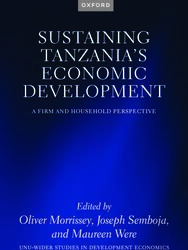Book
Sustaining Tanzania's Economic Development
A firm and household perspective
This book addresses performance and strategies adopted by firms and households in Tanzania to navigate shocks and achieve sustainability. How successful have firms and households been in building resilience to sustain their growth and development? Has the ability to navigate successfully through shocks and a changing economic environment improved? What are the lessons for managing and recovering from shocks?
Several issues are addressed. Export competitiveness, innovation, and developing linkages contribute to the resilience and sustainability of firms, whereas income diversification and financial inclusion promote the resilience and sustainability of households. Gender and regional, especially urban–rural, differences are incorporated.
Cross-cutting themes emerge on the need for modern technology and infrastructure to increase the productivity and employment of firms, investment in human capital to reduce gender inequalities and upgrade or equip workers as well as entrepreneurs with relevant skills, and access to resources for innovation. Performance of Tanzanian firms has gradually improved, although many challenges remain, and this has benefitted households through employment opportunities. The COVID-19 pandemic was a significant shock to the economy and progress stalled or reversed. Tanzania, like most countries, faces a challenging future but is better positioned to do so than it has been.
 Join the network
Join the network